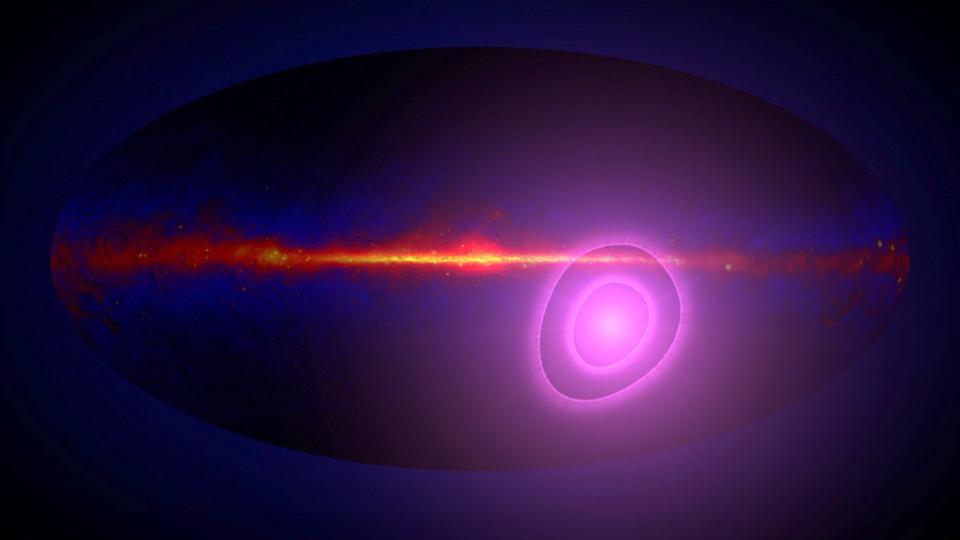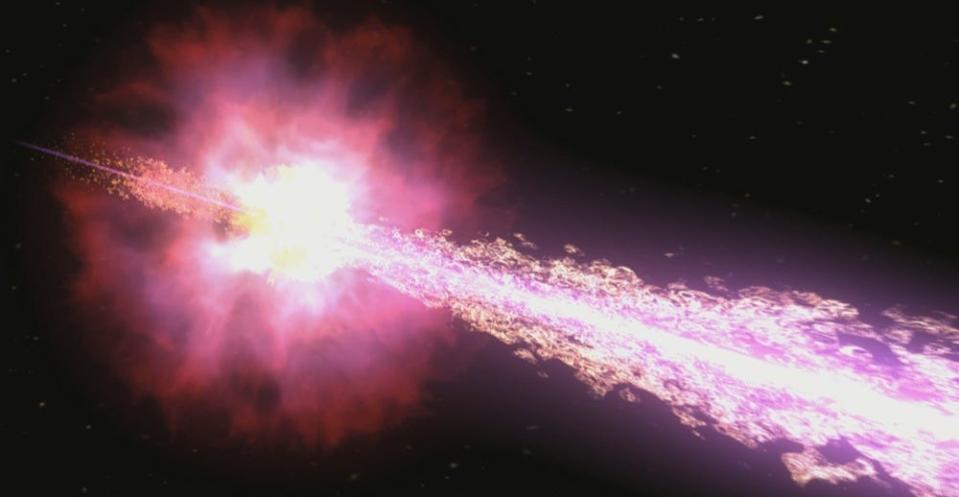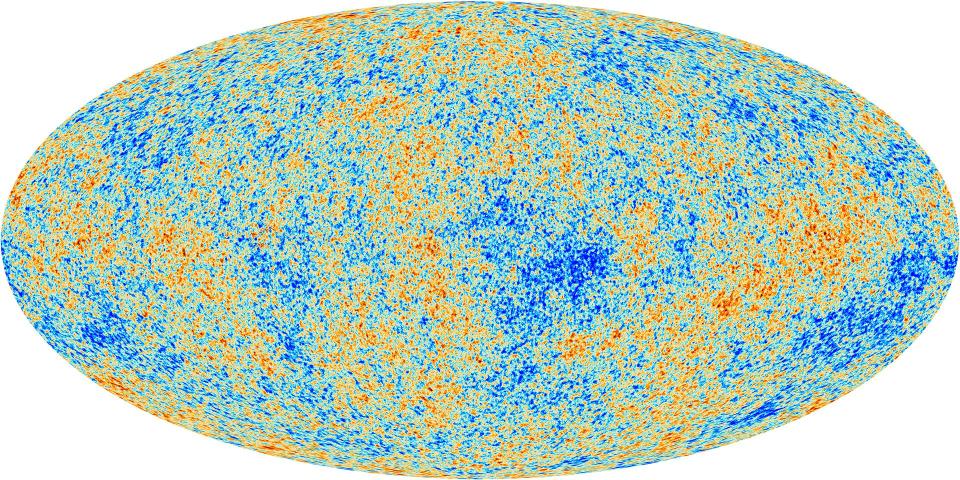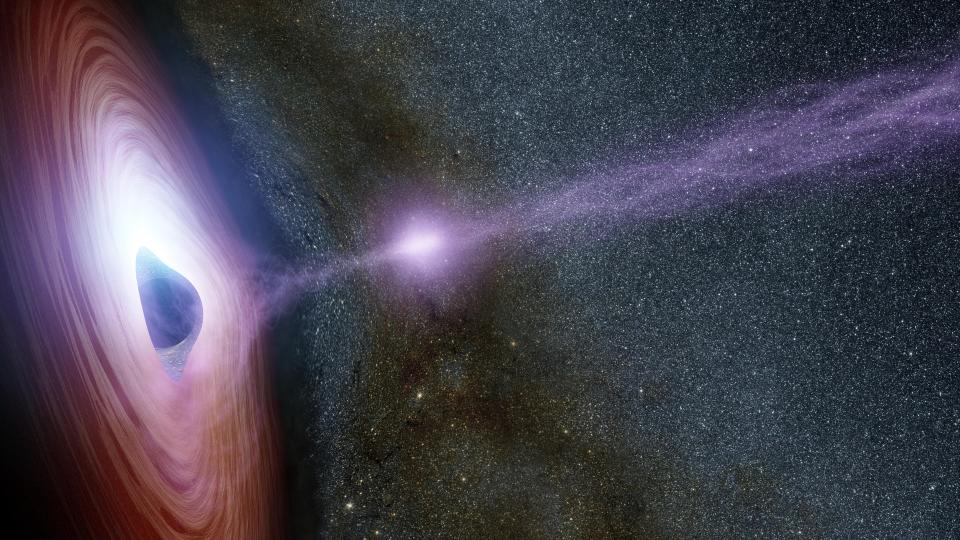-
Astronomers investigating the wallpaper of our universe came across a mysterious signal.
-
Something unknown appears to be emitting high-energy cosmic rays and gamma rays.
-
This pattern in the sky could help solve one of astrophysics’ greatest mysteries.
NEW ORLEANS – Astronomers using the NASA space telescope have discovered a region in the sky where some of the universe’s highest-energy radiation is mysteriously concentrated.
Astronomers were mapping space’s background glow of gamma rays, the brightest and most energetic type of light in the electromagnetic spectrum. They were surprised to see many more gamma rays coming from one part of the sky than from other places.
Alexander Kashlinsky, a cosmologist at the University of Maryland and NASA, described the discovery as “a complete puzzle,” which he presented at the American Astronomical Society meeting in New Orleans last Thursday.
The purple circles in the image below show where they think this signal is coming from. They have 95% confidence that it’s somewhere inside the outer purple ring. It’s probably somewhere inside the inner purple ring. The orange band in the middle of the image is the plane of the Milky Way.


This feature may be due to the hot spot of ultra-high energy cosmic rays (UHECRs) arriving from a similar direction and almost exactly the same magnitude. These are the rarest and most energetic of the charged subatomic particles called cosmic rays.
Unlike gamma rays, which are often found ejecting from black holes and dying or dead stars, the origin of UHECRs is “one of the greatest mysteries in astrophysics,” NASA explained in a statement.
This may be a clue to the mystery, as this unexpected gamma ray feature appears to match a similar feature in UHECRs.
This discovery relates to some of the most intense radiation in the universe. These gamma rays carry approximately 1 billion times the energy of visible light. And UHECRs have 1 billion times more energy than gamma rays.


Kashlinsky and his colleagues don’t know what caused this super-energetic signal in the universe.
But he says it probably comes from an as-yet-undiscovered phenomenon 300 million light-years away from us.
“This is a huge area of sky where it’s hard to know exactly what it is,” Kashlinsky said. said.
looking at the wallpaper of the universe
Kashlinsky and his colleagues encountered this new mystery while analyzing 13 years of data from NASA’s Fermi Gamma-ray Space Telescope.
They were looking for additional signs of a pattern in the cosmic microwave background (persistent radiation from the first light that circulated freely in the universe after the Big Bang). CMB is like the wallpaper behind all the galaxies in the universe.


But there is something strange about this. The CMB is warmer (more microwaves) towards the constellation Leo, while in the other direction it is cooler (less microwaves).
Astronomers think this is due to the background motion of our solar system at about 230 miles per second.
It’s like an ambulance passing by; The siren makes one sound as it approaches you and another sound as it moves away. This pattern in CMB is called a dipole.
Kashlinsky wanted to test this theory about the motion of our solar system by checking whether a similar dipole pattern existed in other types of light.
If other forms of light have different patterns than the CMB, that means it’s not just the motion of our solar system that’s creating the discrepancy. Something else happens; probably an undiscovered event in the first micro-moments of the birth of the universe.
Such a discovery “could give us insight into physical processes operating in the very early universe, potentially less than a trillionth of a second,” said co-author Fernando Atrio-Barandela, a professor of theoretical physics at the university. in Salamanca, Spain, NASA’s press release said.
An unexpected clue to one of the universe’s greatest mysteries
Kashlinsky’s group evaluated the gamma-ray background, the diffuse glow of gamma rays created in the universe by black holes and supernovae.


They found a distinct pattern, but it was 10 times stronger than it should be due to the motion of our solar system.
Moreover, the dipole pattern did not match that in CMB. Instead it matched the pattern of UHECRs.
The discovery in 2017 that UHECRs have their own dipole patterns deepened the mystery around them. Now the discovery that gamma rays have a similar dipole offers a new clue.
A paper describing the discovery was published January 10 in The Astrophysical Journal Letters.
Kashlinsky and his team think the gamma-ray and UHECR patterns may be related, but they’re not sure how or why. An unknown object or process in the universe may be producing both gamma rays and UHECRs.
Kashlinsky told Business Insider in an email that “more studies and better, more precise measurements of both are needed” to solve the mystery.
To this end, his team plans to analyze more Fermi telescope data in the future.
Read the original article on Business Insider